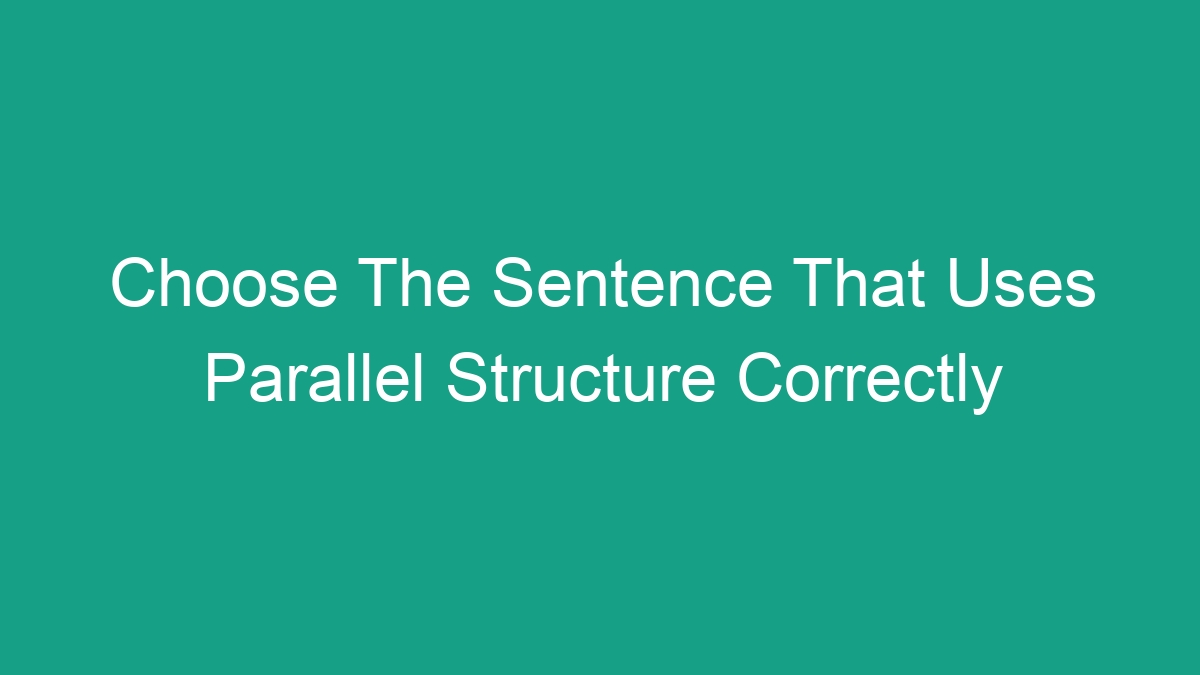
When it comes to writing, it’s important to understand the concept of parallel structure and how to use it correctly in sentences. Parallel structure, also known as parallelism, is the repetition of a chosen grammatical form within a sentence. This repetition is used to create rhythm and balance in writing, helping to make sentences clearer and easier to read. In this article, we will explore the importance of parallel structure and provide examples of how to use it correctly in sentences.
What is Parallel Structure?
Parallel structure involves using the same pattern of words to show that two or more ideas have the same level of importance. This can happen at the word, phrase, or clause level. When the elements in a sentence are parallel, they are similar in meaning and grammatical form. This helps to make the sentence easier to read and understand.
Why is Parallel Structure Important?
Parallel structure is important because it helps to create coherence and balance in writing. When sentences are not parallel, it can make the writing sound awkward and confusing. Parallel structure helps to guide the reader through the text, making it easier to follow the writer’s train of thought. It also helps to create a sense of harmony and rhythm in the writing, making it more pleasing to read.
Examples of Parallel Structure
Here are some examples of parallel structure at the word, phrase, and clause level:
Word Level
- Incorrect: I like hiking, swimming, and to ride a bike.
- Correct: I like hiking, swimming, and biking.
Phrase Level
- Incorrect: The company values hard work, honesty, and being friendly to customers.
- Correct: The company values hard work, honesty, and friendliness to customers.
Clause Level
- Incorrect: She enjoys running in the morning and to go to the gym in the evening.
- Correct: She enjoys running in the morning and going to the gym in the evening.
How to Use Parallel Structure
Using parallel structure is not difficult, but it does require careful attention to detail. Here are some tips for using parallel structure correctly in your writing:
- Identify the elements: Before you start writing, identify the elements that you want to make parallel. This could be a list of items, a series of actions, or a combination of both.
- Ensure consistency: Make sure that the elements you want to make parallel are consistent in their grammatical form. This means using the same part of speech (nouns, verbs, adjectives, etc.) for each element.
- Keep it balanced: Try to make the elements in your parallel structure the same length and complexity. This will help to create a sense of symmetry in your writing.
- Check for clarity: When using parallel structure, it’s important to ensure that the sentence remains clear and easy to read. If using parallel structure makes the sentence too complicated or confusing, it’s better to rephrase the sentence for clarity.
Choosing the Correct Sentence with Parallel Structure
Now that we understand the importance of parallel structure and how to use it correctly, let’s practice by choosing the correct sentence with parallel structure from the following examples:
| Incorrect Example | Corrected Example |
|---|---|
| He likes to jog, swimming, and going to the gym. | He likes to jog, swim, and go to the gym. |
| The new employee was expected to be punctual, friendly, and work with diligence. | The new employee was expected to be punctual, friendly, and diligent in work. |
| The conference will cover budgeting, marketing strategies, and how to negotiate. | The conference will cover budgeting, marketing strategies, and negotiation techniques. |
Conclusion
Using parallel structure in your writing is an effective way to create balance, coherence, and rhythm. By following the tips provided in this article and practicing with examples, you can improve your writing and make it more clear and engaging. Whether you are writing a formal document, an academic paper, or a creative piece, using parallel structure can make a significant difference in the quality of your writing.
Remember to always check for parallel structure when reviewing your work and strive to use it consistently throughout your writing. With practice, using parallel structure will become second nature, and your writing will benefit from its clarity and fluidity.



